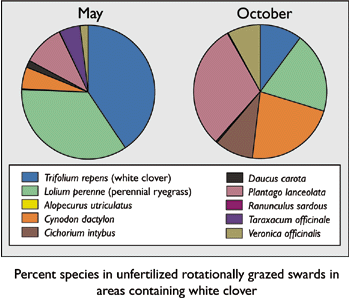 This page has been mothballed.
This page has been mothballed.
It is no longer being updated but we've left it here for reference.
Long term biological and economic sustanability of livestock in Greece

- Collaborators
- Agricultural Development Office Granitsa, Greece
Grasslands of NW Greece contain a diverse range of species, including annual and perennial grasses, annual legumes and other broad-leafed species. However animal production in many areas is limited by low productivity of pasture resources and a lack of appropriate grazing management. High stock densities and a long history of uncontrolled communal grazing have led to serious damage to the vegetation and soil resources.
One solution to improve biological and economic sustainability of livestock production could be an integrated approach of introduction of improved plant material, such as Trifolium repens L. (white clover) and Lolium perenne L. (perennial ryegrass), to increase the production and quality of herbage, and controlled grazing management. However little information was available about the performance of white clover in species-rich swards under Mediterranean conditions in response to different defoliation and fertilizer managements. Furthermore little was known about spatial and temporal dynamics of the component species, although this is well recognised as important in determining species interactions and sward composition.
Our study was set within an experiment to determine the effect of different management regimes on the productivity of sown perennial ryegrass/white clover swards in NW Greece. Sward treatments imposed were a factorial combination of defoliation (rotational grazing by Boutsiko ewes and cutting) and nitrogen fertilization (0 and 40 kg N/ha). There were five defoliation periods (April, May, July, October and November). We tested the hypotheses that defoliation method, N-fertilization and initial content of white clover modified (1) the seasonal dynamics of white clover, perennial ryegrass and eight unsown species in species-rich pastures and (2) the spatial dynamics of white clover at the micro-scale. All measurements were made in 30 x 30 cm microplots divided into nine 10 x 10 cm cells.
There was a changing seasonal contribution of different sward components in the species-rich swards; sown species provided nutritious herbage early in the season until the summer drought, and unsown species were a valuable resource later in the year. Persistence of sown species into the autumn might be increased by using local cultivars that are more adapted to xerothermic Mediterranean conditions.
 The small amount of N
fertilizer applied had an effect on white clover and Ranunculus sardous cover
only. However the method of defoliation influenced to some extent the seasonal
dynamics of white clover, perennial ryegrass, Alopecurus utriculatus, Cynodon
dactylon and R. sardous. These species and Plantago lanceolata were also
affected by whether white clover was present initially, but the reasons
underlying the species-specific responses require further investigation. In
contrast four species (Veronica officinalis, Taraxacum officinale, Cichorium
intybus and Daucus carota) were unaffected by either sward management or white
clover presence. In areas where white clover was initially present, it
persisted in virtually every microplot cell during first three defoliation
periods. After the summer drought its distribution was more patchy and it
occupied only one half of the number of cells. Colonisation of clover-free
areas was slow.
The small amount of N
fertilizer applied had an effect on white clover and Ranunculus sardous cover
only. However the method of defoliation influenced to some extent the seasonal
dynamics of white clover, perennial ryegrass, Alopecurus utriculatus, Cynodon
dactylon and R. sardous. These species and Plantago lanceolata were also
affected by whether white clover was present initially, but the reasons
underlying the species-specific responses require further investigation. In
contrast four species (Veronica officinalis, Taraxacum officinale, Cichorium
intybus and Daucus carota) were unaffected by either sward management or white
clover presence. In areas where white clover was initially present, it
persisted in virtually every microplot cell during first three defoliation
periods. After the summer drought its distribution was more patchy and it
occupied only one half of the number of cells. Colonisation of clover-free
areas was slow.
Management of species-rich sown swards in low-input systems has to consider both overall productivity and sustainability of plant diversity. We found spatial and temporal differences in the contribution of different species to the swards; such differences allow a wide diversity of species to co-exist. Special attention should be paid to the different survival strategies of individual components of the sward and the impact of different management regimes. Management strategies may be required which target the requirements of individual species or groups of species, e.g. cutting rather than grazing to encourage the presence of species which are preferentially grazed and appropriate timings of grazing/cutting to allow seed production of annual species.

